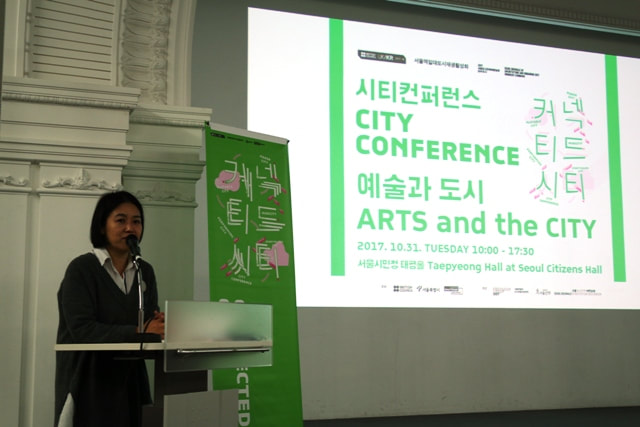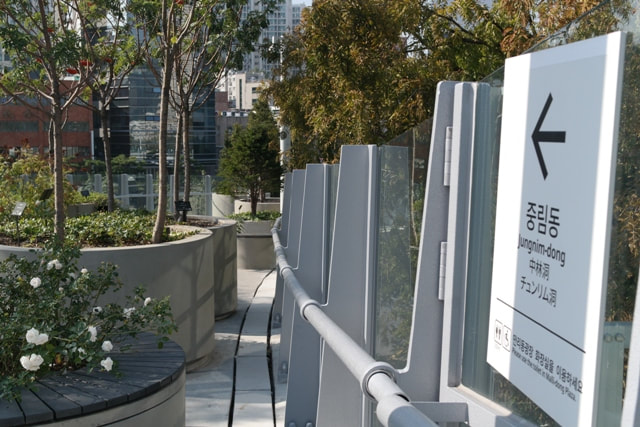|
Catherine GERMIER-HAMEL Based on the assumption that tourists can be considered as temporary yet increasingly engaged citizens, and considering the importance of culture in tourism growth and its contribution to the congestion of many tourist destinations, I was very eager to attend the City Conference which took place on Oct. 31, 2017 at the Seoul Citizen's Hall under the theme "Arts and the City", within the framework of the Connected City project. This very informative and captivating conference was hosted by the Seoul Metropolitan Government and the Seoul Design Foundation, and was organized by Producer Group Dot, the Urban Regeneration Center of Seoul Metropolitan Government, Seoul Walk, and the Seoul Biennale of Architecture and Urbanism. Through gathering Korean and British speakers - creators and curators - working together to connect local communities in the city, the conference was aimed at sharing experiences and views on the rapid changes affecting urban environments, their impacts on the daily lives of the citizens, and how the arts should (or could) reflect this constant evolution. The event also intended to discuss the role played by the arts and technology in the development and culture of a city, and how they can invite citizens to think about the city in more diverse, different and inclusive ways. Whereas the Sustainable & Smart Tourism Forum is about to become a full-fledged organization, with chapters in Korea and China, the City Conference was a great source of inspiration. However, I have noticed that the words "smart" and "sustainability" have not been often used during this conference, suggesting they may not have been really assimilated in the cultural and artistic spheres. Talking about public art in Seoul, one of the speakers suggested that artists are not taught about global issues. The programme of the conference included two parts: The first part was titled Five Ways to Explore the city and was moderated by Mr. Ilwoo Joo, Publisher and Director of Eum Books. It featured five presentations: 1. Culture in Cities - Why does it matter? by Justine Simons OBE, Deputy Mayor, Culture and Creative Industries, London. During her presentation, Justine reminded that culture is all about human connections, whereas technology gives the illusion of connectivity. She introduced the case of London, as a leading creative capital, and the most Googled city for culture. Culture is actually the number one reason for people to visit London. Culture gives the distinctiveness and creativity of the city, as well as its diversity of people and ideas. According to her, culture offers solutions through the creative economy and contents will be the key (I guess they already are). Creative jobs are jobs of the future and artists will play a strong role. She quoted Albert Einstein: "Logic will get you from A to B. Imagination will take you everywhere." Justine founded and is chair of the World Cities Culture Forum, an influential network of 35 global cities championing the pivotal role of culture. 2. Seoul Biennale, or Committing to Place, by Hyungmin Pai, Director of the Seoul Biennale of Architecture and Urbanism. After declaring that places are created not by buildings but by human commitments, Hyungmin introduced the Biennale and its innovative concepts and projects, and how they can be part of a place-making process. He stated that commitment to a place is not confined to those who take permanent residence. He cited the examples of the Pyongyang Sallim, an accurate recreation of a typical apartment in North Korea's capital city, introducing the daily life of ordinary people in the North Korean capital, the Sewoon basement project, an exhibition located under the new Sewoon Shopping Center that has been opened in September 2017, as the regeneration of the once mecca of Korea’s electronics industry, or the Donuimun Museum Village that has been open on the occasion of the biennale. "The Seoul biennale is not only an exhibition about the fixed spaces of the contemporary city but also a testing ground for the commons. It is not only about the commons as an entity but also a small but intricate part of the process of "commonning". Hyungmin Pai, a historian, critic, and curator, is profesor at the University of Seoul. 3. Different Approaches for Development of Cultural Identity in the City by Kyu Choi, Creative Director of UK/Korea 2017–18, British Council Choi evoked different approaches for development of cultural identity in the city, highlighting that "over the past few years, [Seoul] has pursued various policies that have evolved from 'growth and development' to 'sharing, coexistence and cooperation'". He insisted on the importance sustainability to change the city in a healthier way, and the necessity for the role of artists to change to become communicators and innovators, while taking more risks and using more their imagination. He also evoked the need to engage in grassroots activities, and to move from outer space to inner space. Choi mentioned three points to consider when approaching the city as a creator: diversity, inclusiveness, and sustainability, and also evoked the different challenges and long-term problems to overcome that are often linked to one-sided, top-down policies. 4. Arts and Public realm – The Illuminated River by Sarah Gaventa, Director of the Illuminated River Gaventa introduced the Illuminated River project and stressed the necessity to listen to people and to reach a consensus between all stakeholders involved in such complex project, adding that it has encouraged "new thinking and more partnership working, unlike many cities which only have one public body to consult." 5. Future of Public Arts in the City of Seoul by Kyuchul Ahn, Professor, Korea National University of Art. The presentation of Prof. Ahn focused on public art in Korea, and the need for new imagination. For him, there are too many public artworks in Seoul, and some of them are actually rejected by the citizens since they are not proposed but imposed and constantly exposed. The issue is getting even more controversial when those pieces are financed by taxpayers. According to him, "we should quell our desire to put our name in order for public art to not be just an unnecessary appendix added to the city, we must imagine a new public art as a public space for the next generation, as a place where public life can unfold." Prof. Ahn called for more storytelling. This first part was concluded by a discussion and Q&A session. The second part featured Creatives' Views of the City, with presentations by artists, producers and curators from Connected City, Seoul Biennale of Architecture and Urbanism and Busan Inter-city arts projects, who shared their experiences, perspectives, visions and sometimes challenges and frustrations. This session was moderated by Jisun Park, Creative Producer of Connected City. Presenters included: Su-in Yang, Curator of Walking the Commons, Seoul Biennale of Architecture and Urbanism Hilary O'Shaughnessy, Producer of Playable City Suna Choe, Producer of Maker City – Seogyedong Nick Luscombe, Producer of Musicity Miryoung Oh, Producer of Storytelling City Seungwook Lee, Director of Busan-Sheffield Inter-city Arts Project. This second part was followed by an open discussion between the presenters. During this conference, it came to my mind that overtourism often happens (and/or is felt) in places of cultural and artistic significance, and particularly UNESCO-listed sites, where it seems there is a clash over ownership between the locals and the visitors. Being overexposed, such sites are therefore threatened. But can we really blame tourists for willing to enjoy our common world heritage ? Through creating new artistic and cultural attractions in less visited neighborhoods, in collaboration with local citizens and without disturbing their daily lives or displacing them, it might be possible to divert the excessive flows of tourists and visitors while revitalizing some declining areas. The main purpose is not necessarily to gentrify or even beautify, but to give more exposure to places that have been been kept in the shadow of more popular and appealing landmarks, and to generate new income and job opportunities for them. Leading tourist to the outskirts or even the countryside (think about land art) by the means of cultural / art sites and routes, permanent or temporary, can also be an option. And of course, quality over quantity should be the driving principle. As a foreign resident of Seoul since 2005, I have witnessed many urban development / renewal projects that made me react more or less enthusiastically or sarcastically, according to the mood of the day. Cheonggyecheon Stream, Gwanghwamun Plaza, Dongdaemun Design Plaza, Seoullo 7017, Seoul 20, etc. All in all, I believe those alterations or constructions have been planned for the best interests of the city (if not the financial interests of its citizens), and are now part of its heritage (and not only a legacy for the mayors). In total contrast with Paris where I lived during three years before being relocated to Korea, the capital of Korea did not strike me at first sight with the beauty or the majesty of its architecture and monuments, but it rather amused me with its "Legoland look", its colorful cacophony of structures, and its heterogeneous mix of old-fashioned and avant-garde buildings. I was actually quite amused by this playground for adults dotted with a plethora of kitschy public art creations. Very quickly, I had resolved to explore the streets of Seoul (together with its belly) and take pictures of those artworks located at the foot of almost all buildings. Even more rapidly, I gave up this Herculean initiative due to the magnitude repetitiveness of the task. Not only these pieces were ubiquitous but they were also boringly similar, to the point I assumed they were the products of only a handful of artists. I had called this project "Seoul 0.7", corresponding to the percentage of the construction cost to be allocated by the building owners to artworks for public view. See article about Public Art in Korea here and "a few" pictures below. Having said that, I have barely complained about new additions in the Seoul landscape, in spite of some controversies sparked among my fellow citizens, foreigners included. Not only I did not have enough information about the background and budget of such projects but also I was just satisfied to notice how Seoul was becoming an increasingly livable, eco-friendly, and "aesthetically acceptable" (well according to my personal tastes) city. In many ways, I believe foreign tourists and visitors have different perspectives than local residents about culture and art in the city. And in spite of having taking roots in Seoul for over a decade, it took me many years to abandon my tourist mindset, which probably helps me keep a fresh perspective of Seoul urban development.
0 Comments
Leave a Reply. |
Archives
February 2024
|
|
France - Cambodia
|
|
Promoting Positive Places, Practices and Experiences
|
Icons by Freepik from www.flaticon.com
|



